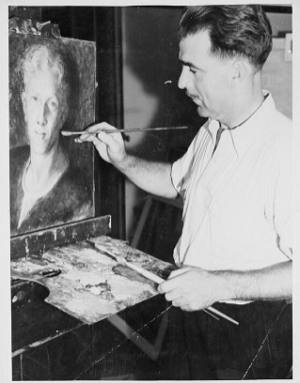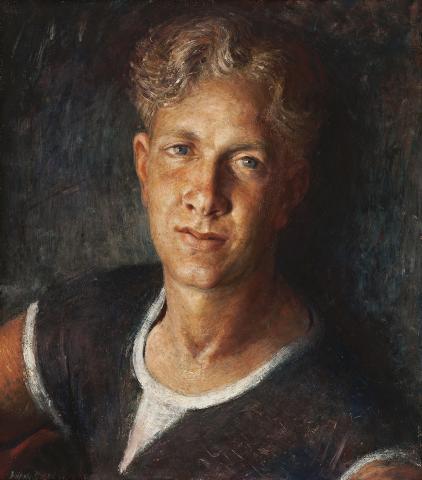DAVID CHAMBERS, 1946
WILLIAM DOBELL
oil on composition board
48.0 x 43.5 cm
signed and dated lower left: William DOBELL 46
Commissioned by Mrs John Ferguson Chambers, the sitter’s mother
remarried as Mrs Douglas McKaen Tooth, New South Wales (inscribed D.M. Tooth on AGNSW label verso)
Joseph Brown Gallery, Melbourne
Ted Lustig Collection, Melbourne, acquired from the above in 1978
Sotheby's, Melbourne, 21 November 2006, lot 6
Gould collection, Melbourne
William Dobell Retrospective, Art Gallery of New South Wales, Sydney, 15 July – 30 August 1964, cat. 103 (label attached verso)
Spring Exhibition 1978, Recent Acquisitions, Joseph Brown Gallery, Melbourne, 25 September – 9 October 1978, cat. 108 (illus. in exhibition catalogue)
Director’s Choice 2007, Gould Galleries, Melbourne, 17 February – 30 March 2007, cat. 5 (illus. in exhibition catalogue)
Director’s Choice 2012, Gould Galleries, Melbourne, 19 July – 31 August 2012, cat. 6 (illus. in exhibition catalogue)
Penton, B., The Art of William Dobell, Ure Smith, Sydney, 1946, p. 114 (illus., dated as 1944)
Gleeson, J., William Dobell, Thames and Hudson, London, 1964, cat. 139, p. 195 (illus., dated as 1944)
8. William Dobell working on his painting of David Chambers, 1946.png

WILLIAM DOBELL WORKING ON HIS PAINTING
OF DAVID CHAMBERS, 1946
photographer unknown
National Library of Australia, PIC/14144/17,
courtesy of the Sir William Dobell Art Foundation
This masterly portrait by William Dobell dates from the immediate aftermath of one of the most famous incidents in Australian art history, when the artist was forced to defend his portrait of colleague Joshua Smith after it won the 1943 Archibald Prize. Dobell had spent many months sharing a tent with Smith, allowing for close scrutiny of his future subject whilst the two had worked together in the wartime Civil Construction Corps. His friend was an extraordinarily skinny and sharp edged man, facts which Dobell heightened in the final painting. Vitriolic opponents claimed it was a caricature and even though Dobell won the subsequent court case in 1944, the hostile publicity surrounding it caused a physical and physiological breakdown for the artist. In poor health, Dobell retreated from public scrutiny but even so, winning the Archibald assured Dobell’s career and his work was featured in a number of noted exhibitions in late 1944 and 1945. Dobell spent months recovering but by 1946, his prowess as one of the country’s most skilled and penetrative portrait painters returned. David Chambers dates from this year and is as revealing and humanist as any of the artist’s portraits from the 1940s. Indeed, it seems to glow with some incandescent inner light, a restorative force not unlike that which Dobell himself must have felt.
David Chambers, 1946 was a private commission by the sitter’s family, noting that such a display of support at this time was highly significant for the struggling artist, for his public reputation and for the acceptance of modernism in general. At the time of the Archibald controversy, Dobell had commented that ‘(p)eople … expect a portrait to be simply a coloured photograph, and they would restrict the artist to painting things just as they expect them to appear. … You might say that I am trying to create something instead of copying something when I set out to paint a portrait. … The real artist is striving to depict his subject’s character and to stress the essentials of gesture and features, (that is, an) art which is alive.’1 As if painted directly to this formula, David Chambers bristles with the sensuous masculinity of its 21 year-old sitter, a handsome young man wearing a nautical vest, indicative of his great love of sailing on Sydney’s expansive harbour. He was also racing car enthusiast as reported in the Sun newspaper: ‘Eligible David Chambers is really off to revive family fortunes as an Australian independent car-driver in speed trials all over France.’2 Prior to his premature death at the age of 28, the wealthy bachelor ordered a Cooper-Bristol Mark II RedeX Special from England. When Chambers never took delivery, the car was subsequently purchased from his estate by Jack Brabham, and after modification, raced in the 1954 New Zealand Grand Prix.
Dobell’s painterly treatment of the background in this portrait gives Chambers a marked intensity, even an inner radiance, with its scumbled then glazed blue-black brush marks presenting the appearance of a swirling halo in deep space, its ambiguity contrasting with the sitter’s finely delineated blonde hair, grey-blue eyes, dimpled chin, and fleshy nose. No doubt Dobell was equally happy with the result and allowed himself to be photographed as he worked on the painting’s finer details. It also marked a return in his confidence as an artist and led indirectly to his next major triumph when Dobell won his second Archibald Prize in 1948 with his now-famous portrait of the young Margaret Olley.
1. ‘Portrait Prize Defended: Mr. Dobell replies to critics’, Sydney Morning Herald, Sydney, 31 January 1944, p. 2
2. ‘An ‘eligible’ is off to France’, The Sun, Sydney, 24 February 1949
ANDREW GAYNOR
